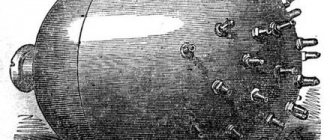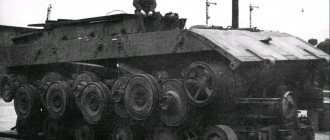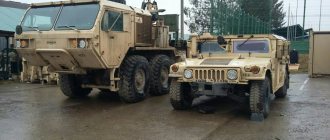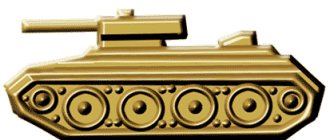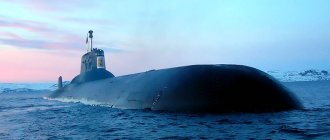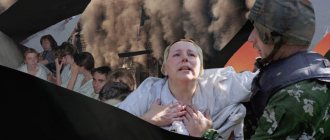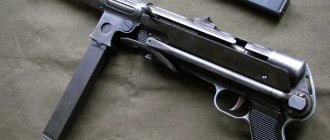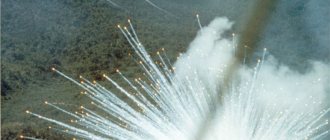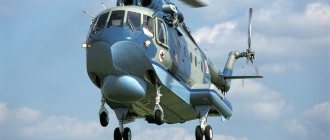The history of the creation of the Fi.103 (V-1) projectile aircraft
In 1939, the German inventor F. Gosslau approached the Reich Ministry of Aviation with an invention called the “ flying bomb ”. The project was immediately described as completely unrealistic - after all, equipping a bomb with wings and a jet engine, this could only have occurred to the authors of science fiction novels.
And then the war began. Until the end of 1941, everything went quite successfully, but already on the eve of 1942, the German military machine stalled, and therefore more and more fantastic projects began to appear one after another. " projectile plane " proposed and the Argus was essentially the same "flying bomb" as two years earlier. However, this time the Reich Ministry grabbed the idea with both hands, and even sent out the leading designer R. Lusser to work on this project.
The preliminary design coded "Gosslau P-55" was approved on June 5, 1942 and received the designation Fi-103 (from the name) and the highest development priority. To ensure secrecy, the true purpose of the device was masked by the name Flakzielgerat FZG-76 - it is a “target for anti-aircraft artillery.” By modern standards, naturally, it would be more appropriate to call the Fi-103 not a projectile aircraft, but a guided missile.
Drawing of the Fi.103 projectile (V-1, V-1)
All further design and testing work was transferred to the E-center Karlshagen and Peenemünde West, located on the island of Usedom in the Baltic Sea. As the power plant of the projectile aircraft, it was decided to use a pulsating air-breathing engine, developed in 1938 under the leadership of P. Schmidt. Developed the control system.
The engine was tested on the experimental Me-110, and already on August 30, 1942, the production of the first prototype Fi-103 and the construction of a 55-meter catapult for it were completed.
After a series of unsuccessful launches on December 24, the twelfth projectile aircraft still made a successful straight flight 3 km long. In the summer of 1943, preparations began for mass production at 4 factories at once: in Nordhausen, Ham, South Fallersleben and Magdeburg-Schönebeck. Another 50 companies were involved in the production of components. In August 1943, a special detachment (about 750 people) under the command of M. Wachtel began to master the new technology, but due to delays and difficulties in mastering the new technology, the order to begin the combat use of the new weapon was signed by Hitler only on May 16, 1944.
Aircraft-projectile Fi.103 (V-1, V-1) in an unmanned version. In fact, it’s a completely modern cruise missile
Modifications[edit | edit code]
During the production of the V-1, several modifications of it (including specialized and manned ones) were developed or proposed by designers. Only some of them were used on the battlefield.
V-1 air launch[edit | edit code]
V-1 on a modified He 111 Arado Ar 234 Blitz mit V1
In addition to launching the rocket from ground sites, the Germans also practiced launching V-1s from flying bombers. No modification of the rocket was required, since its prototypes were already adapted for air launches during engine testing. The V-1 was usually carried by Heinkel He 111 H-22 bombers. The missile was attached under the wing of the bomber, with the projectile engine protruding above the upper surface of the wing.
Airborne missile launches began in July 1944. The Germans saw air launches as a way to compensate for the loss of launch sites in the Pas de Calais, which had been captured by the Allied offensive. In addition, missile-carrying aircraft could launch missiles from unexpected directions, complicating the actions of British air defense.
Due to the activity of Allied fighters, missile missions were carried out only at night, and only at low altitudes to avoid radar detection. The bomber approached Britain and crossed the coastline at low altitude, then climbed, launched a missile, and quickly descended again. However, the tactic was dangerous: in addition to the fact that the He-111 itself was an outdated machine, the bright flash of the rocket engine turning on revealed the carrier in the darkness of the night. In addition, air launches were less reliable. In total, about 1,176 V-1 missiles were launched from carrier aircraft.
Subsequently, the Germans also proposed to develop a modification of the V-1 for launch from Arado Ar 234 Blitz jet bombers. In this case, the rocket had to either be towed behind the aircraft on a flexible suspension, or installed on top of the fuselage. These plans were not implemented.
Long-range V-1[edit | edit code]
The Allied landings in Normandy in the summer of 1944 led to the capture of the German launch sites in Pas-de-Calais, from where the V-1 was launched into London. The basic version of the missile did not have sufficient range to be used effectively against the UK from more distant launch sites.
In an attempt to solve this problem, a new, longer-range version of the missile was developed. The fuel capacity was increased by reducing the weight of the warhead. In addition, the nose cone of the rocket, which was metal in the original version, began to be made of wood, which led to a significant reduction in the weight of the structure. The new missiles could be fired across the UK from more distant launch sites in the Netherlands. The Germans feverishly tried to organize mass production of long-range missiles by the winter of 1944-1945, but due to the general collapse of the German economy and the destruction of industrial plants by bombing, a new "robotblitz" began only in February-March 1945, when several hundred missiles were launched at London from launch sites in the Netherlands. Soon after this, the decisive offensive of the Anglo-American troops led to the loss of these positions by the Germans.
Manned V4 (V-4)[edit | edit code]
Main article: Fieseler Fi 103R Reichenberg
Manned version of the cruise missile - Fieseler Fi 103R
Manned version of the Fieseler Fi 103R, or V4, cruise missile; was to be used against armadas of Allied bombers. The cockpit was located at the rear of the fuselage, in front of the engine diffuser:
The pilot had to direct the plane to the target and then bail out. By 1944, 175 examples had been built. A project to use the V4 as a kamikaze weapon was seriously developed. For this purpose, an army operation to train suicide pilots was created. A total of 200 such pilots were trained. Although the V-4 aircraft were never ultimately used by suicide pilots, pilots from this program were used with existing aircraft.
In addition to these programs, the Germans also considered the possibility of using the projectile aircraft as a towed fuel tank for jet fighters. The projectile, devoid of an engine and warhead (essentially just a tank with wings and an autopilot) was to be towed behind the Me-262 and dropped when its fuel supply was depleted. The project underwent several testing tests by towing behind a He-177 heavy bomber, but in the end it was not put into practice.
Combat use of the Fi.103 (V-1) projectile aircraft
Unlike modern cruise missiles, the V-1 (Fi-103) was not a highly accurate weapon, but rather a "highly inaccurate" weapon. The missile impact location fit into a square of 4x4 kilometers, so relative success could only be achieved by launching missiles in “packs”, moreover, at large-sized targets. Shooting at cities (it is difficult to find a larger target) seemed to be the optimal way to use the V-1 in combat. The first target of Hitler's cruise missiles was supposed to be London. Remembering the terrible bombing of Hamburg by British bombers in the summer of 1943, the Germans introduced another designation for the V-1: V-1, that is, Vergeltung-1, “weapon of retribution.”
Hitler was waiting for a miracle, but the miracle did not happen. The British knew in advance about the “weapons of retaliation” and first of all bombed the launch sites and factories for the production of V-1. The fighters were also promptly warned about the new German weapon, and since the flight of the projectile aircraft was carried out strictly in a straight line, and at a relatively low speed, the pilots soon learned to shoot them down quite easily along the way. By the end of the war, no more than 10% of the V-1s released reached the target.
The first combat use of the V-1 (Fi-103) took place on the night of June 16, 1944. 244 missiles were fired at London - partly from He-111H-22 aircraft, partly from ground launchers in Normandy. Of course, this was only a test balloon - the Nazis managed to rivet no less than 25 thousand aircraft-shells. However, until the surrender, they were never able to shoot this impressive arsenal: a total of 10.5 thousand V-1s were produced, for the rest there was simply not enough fuel and launchers.
In total, according to English data, 6,364 people died from “weapons of retaliation” and about 18,000 were injured.
Fi.103 (V-1, V-1) transported on an Ar-234 aircraft. Just think - the world's first jet bomber with the first full-fledged cruise missile on board!
Interceptors, anti-aircraft guns, bombs
It was difficult to shoot down missiles. Firstly, detecting a single target was not easy even with radar. And when this was successful, there was very little time left for interception.
It was necessary to send fighters to it, and they had to be fast enough to catch up with the missile and have heavy small arms to shoot the metal projectile.
Machine guns were not suitable - their bullets often ricocheted without causing much harm to the metal body. The guns coped with the task well. But it was not worth approaching the missile - if a ton of explosives exploded, the interceptor itself could be damaged.
As a result, through trial and error, it was found that the modernized Hawker Typhoon fighter, called the Tempest, was best suited for this purpose.
This most powerful British single-engine fighter carried four 20-mm cannons, which gave the missile little chance.
Image copyright PA Image caption Avro Lancaster beavers immediately destroyed any detected launch sites
In total, this aircraft accounted for 638 V-1s shot down. In addition, twin-engine Mosquito, Spitfire and Lend-Lease American Mustangs also took part in the missile hunt. At some stage, the first English Gloster Meteor jets began to hunt for winged bombs. But not a single car broke the Tempest record.
Britain also improved other methods of combating cruise missiles. New radio fuses on artillery shells of anti-aircraft batteries turned out to be incredibly effective.
A conventional fuse was triggered either at a certain altitude at a point where there might not be a missile at that moment, or when it hit a flying vehicle, which happened infrequently.
The radio fuse was triggered at a certain distance from the flying missile, guaranteed to destroy it - even a simple blast wave could destroy the V-1. The number of downed missiles has increased significantly.
Design of the Fi.103 (V-1) projectile aircraft
The V-1 projectile (Fi.103) is built according to the aerodynamic design of the mid-wing. The wing is rectangular with one tubular spar; there is no wing mechanization.
The elevator and heading rudders, as well as the gyroscopes, were driven by compressed air, which was stored in 2 150-liter balloons under a pressure of 180 kg/cm2.
Steel was widely used in the design, which ensured the low cost necessary for a disposable aircraft. Only the nose compartment of the fuselage, in which the “magnetic corrector” was located, was made of duralumin. The second compartment housed the warhead, the third - the fuel tank and balloons, the fourth - the autopilot and elements of the power plant.
The warhead was equipped with three contact fuses. The power plant consisted of an As.014 pulse jet engine mounted on the fin tip. Low-octane gasoline was used as fuel. The fuel was supplied through a pipeline in the pylon supporting the front of the engine.
The Fi-103 was equipped with an inertial guidance system. Most projectiles could only fly in a straight line (the course was set by the direction of launch from a guide). At the end of the war, some of the projectile aircraft were equipped with turning devices, which made it possible to perform turns in accordance with the program.
The flight altitude was set using a barometric altimeter in the range of 200-3000 m. The distance to the target was determined by a counter installed in the nose and driven by a small propeller. Upon reaching a pre-calculated distance, the counter turned off the engine and sent a command to the elevator, after which the projectile went into a diving flight.
Project evaluation
Memorial plaque on Grove Road, Mile End in London commemorating the site of the first V-1 shell falling on 13 June 1944, which killed 11 Londoners.
In late December 1944, General Clayton Bissell presented a report pointing out the significant advantages of the V1 over traditional aerial bombing[8].
He prepared the following table:
Comparison of Blitz (12 months) and V1 flying bombs (2 ¾ months)
| Blitz | V1 | |
| 1. Cost for Germany | ||
| Departures | 90 000 | 8025 |
| Bomb weight, tons | 61 149 | 14 600 |
| Fuel consumed, tons | 71 700 | 4681 |
| Aircraft lost | 3075 | 0 |
| Lost crew | 7690 | 0 |
| 2. Results | ||
| Structures destroyed/damaged | 1150 000 | 1127 000 |
| Population losses | 92 566 | 22 892 |
| Ratio of losses to bomb consumption | 1,6 | 4,2 |
| 3. Cost for England Efforts of escort aircraft | ||
| Departures | 86800 | 44 770 |
| Aircraft lost | 1260 | 351 |
| Lost man | 2233 | 805 |
In general, in terms of cost/effectiveness ratio, the V-1 was a fairly effective weapon (unlike the significantly more expensive V-2). It was cheap and simple, could be produced and launched en masse, did not require trained pilots, and in general, even taking into account the significant losses of projectile aircraft from British counteraction, the damage caused by the missiles was greater than the cost of producing the missiles themselves. A fully assembled V-1 cost only 3.5 thousand Reichsmarks—less than 1% of the cost of a manned bomber with a similar bomb load [ source not specified 2403 days
].
It should also be taken into account that countering missile attacks required significant efforts from the British, involving a multitude of anti-aircraft guns, fighters, searchlights, radar and personnel, and as a result, the cost significantly exceeded the missiles themselves, even without taking into account the damage caused by the latter [ source not specified 2403 days
].
Characteristics of "Fieseler"-103 or V-1
A country:GermanyType:Projectile planeYear of issue:1942Crew:0-1 peopleEngine:1x As.014 with a power of 300 kgfMaximum speed:800 km/hPractical ceiling:1000 mRange of flight:280 kmEmpty weight:1500 kgMaximum take-off weight:2250 kg (normal takeoff)Wingspan:5.3 mLength:7.73 mHeight:1.7 mWing area:8 sq.m.Weapons:The mass of the warhead is 850 kg.Modifications of the Fi.103 (V-1) projectile aircraft
- Fi.103A-1 - the first production version.
- Fi.103B-1 - simplified. Some of the structural elements are made of wood, and the wing span is increased. Not serially produced.
- Fi.103B-2 - experimental with a Trialen explosive warhead.
- Fi.103C-1 - experimental with the SC-1800 aerial bomb as a payload.
- Fi.103F-1 - with an increased launch range of up to 370 km. Developed in early 1945. Didn't pass the test.
- "Reichenberg" I - a manned version for a kamikaze pilot. It was distinguished by a landing ski and a small cabin in front of the air intake. Developed at the German Glider Institute. First flight in September 1944, not used in combat conditions.
- "Reichenberg" II - training. It featured a two-seater cabin with dual controls.
- "Reichenberg" III - modified. It was distinguished by flaps and ballast in place of the warhead.
- "Reichenberg" IV - combat version. It was distinguished by the presence of a warhead. 175 Fi.103 missiles were converted.
- 10X - Soviet analogue of Fi.103. It was developed in 1945-1946 at OKB-51 under the leadership of V.N. Chelomey.
- JB-2 - American analogue of Fi.103.
Manned version of the Fi-103. The V-1 never became a weapon of retaliation, but modellers love it.
Source: Kozyrev V.M., Kozyrev M.E. German projectile aircraft, Wings of the Motherland., 2001.
